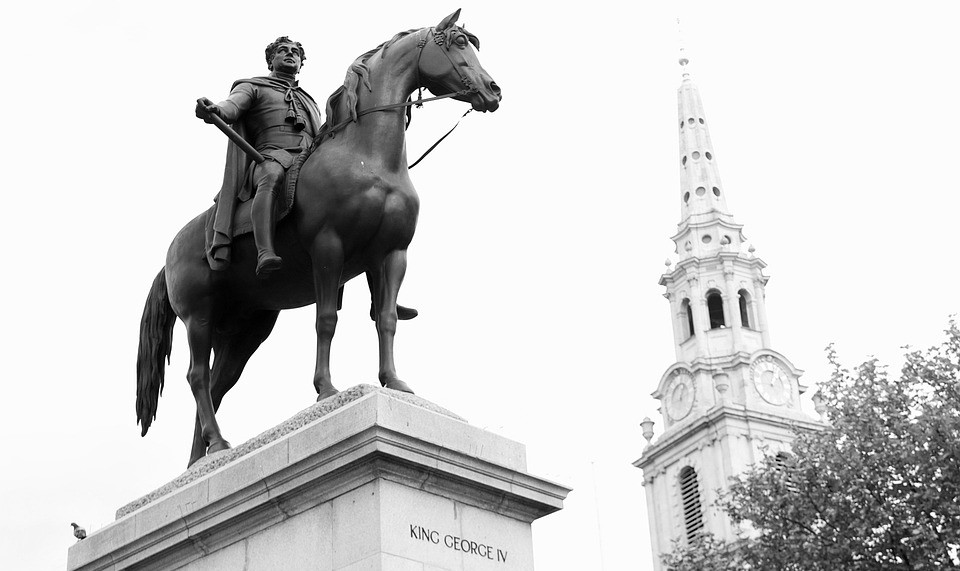
George IV was King of the United Kingdom and other realms from 1820 until 1830. Here, we will be exploring the life and reign of George IV.
George IV’s Early Life
George IV was officially born George Augustus Frederick on 12th August 1762 at St James’s Palace. He was the eldest child of King George III and Charlotte Sophia of Mecklenburg-Strelitz. He automatically became the Duke of Cornwall and Duke of Rothesay at birth, and then became the Prince of Wales and Earl of Chester a few days later. On 18th September 1762, George was baptised by the Archbishop of Canterbury, Thomas Secker.
Growing up, George was a talented student and learned to speak multiple languages, including French, German and Italian. When he turned 21, George established his residence in Carlton House, where he lived an extravagant life. His lifestyle caused a rift between him and his father, resulting in the King regarding him with contempt.
Marriages
In 1784, George met and fell in love with Maria Fitzherbert; a Roman Catholic who was six years older and twice widowed. The couple secretly married on 15th December 1785, however, their marriage was illegal due to the Royal Marriages Act 1772, which prohibited marriage without the King’s consent. Gossip of this illegal marriage spread, and because the revelation of this would have caused a national scandal, it was declared that the rumours were false. Maria was unhappy with the denial of the marriage, and cut all ties with George.
George’s extravagant life had left him in increasing debt, and his father refused to help him unless he married his cousin Princess Caroline of Brunswick. Therefore, they were married at the Chapel Royal, St James’s Palace on 8th April 1795. The couple, however, were completely unsuited to each other, and their marriage was disastrous. Their only child, Princess Charlotte, was born on 7th January 1796 and they formally separated shortly after this. It is believed that George remained attached to Maria for the rest of his life.
Reign of King George IV
Following the death of his youngest daughter, Princess Amelia, King George III’s mental health broke down, and he was declared insane. In 1811, the Regency Act was passed, and George became Prince Regent under these terms. As the Prince Regent was heir apparent to the throne and would assume full powers upon his father’s death, this Regency era did not require a Council of Regency, and so the majority of powers were passed to George IV. George decided to retain his father’s ministers rather than appoint his old Whig friends.
King George III died on 29th January 1820, and the Prince Regent ascended the throne as King George IV. His coronation took place at Westminster Abbey on 19th July 1821. Although he and his wife had been separated since 1796, Caroline decided to assert her rights as queen consort. The King sought a divorce, however, as none of them would admit to adultery, there was no grounds for divorce. He therefore introduced the Pains and Penalties Bill, which allowed Parliament to impose legal penalties without a court trial and would allow him to divorce his wife. This bill was extremely unpopular with the public and was withdrawn from Parliament. The King excluded his wife from his coronation, and she died on 7th August 1821.
George IV’s accession did not add to the powers that he had already possessed as regent. His character was redeemed partly by his intellectual abilities and artistic judgments; he patronized John Nash, the architect who developed Regent Street and Regent’s Park and commissioned the remodel of Buckingham Palace; and he sponsored Sir Jeffry Wyatville’s restoration of Windsor Castle. George’s most famous attraction was the Royal Pavilion at Brighton, which was designed by Nash. He also acquired many works of art which are now in the Royal Collection, and his love for glamour and spectacle displays helped to develop the ceremonial side of monarchy.
Death
George’s indulgent lifestyle had taken its toll on his health by the late 1820s and he spent most of his later reign in seclusion at Windsor Castle. He had become blind in one eye, obese and had arthritis, arteriosclerosis, fluid retention, and liver disorders. In his last years, he spent his days in bed and had serious spasms of breathlessness. King George IV passed away on 26th June 1830. An autopsy revealed that he had died from upper gastrointestinal bleeding from the rupture of a blood vessel in his stomach.
On 15th July 1830, the King was buried in St George’s Chapel, Windsor Castle. His only legitimate child, Princess Charlotte, had died during childbirth in 1817, and George III’s second son, Prince Frederick, had died childless in 1827, so the throne was passed to George IV’s younger brother, William, who became King William IV.


